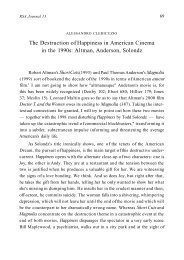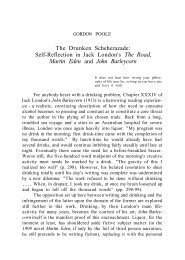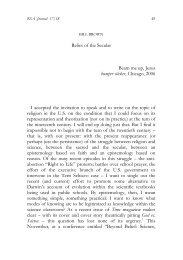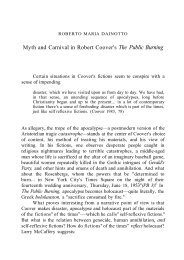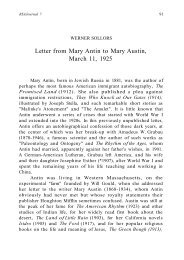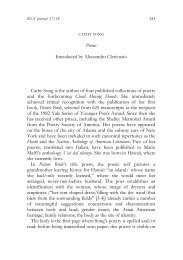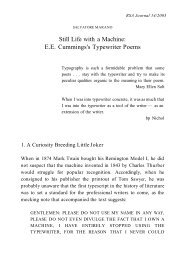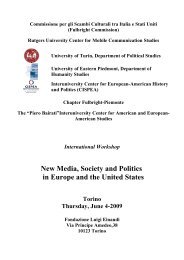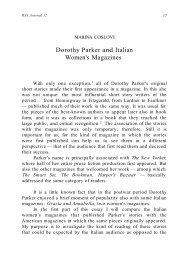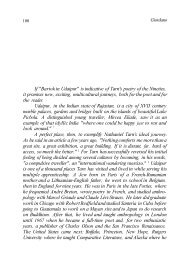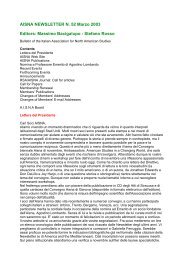An American Jeremiah in Rome: A Study of Margaret Fuller's ... - aisna
An American Jeremiah in Rome: A Study of Margaret Fuller's ... - aisna
An American Jeremiah in Rome: A Study of Margaret Fuller's ... - aisna
- No tags were found...
You also want an ePaper? Increase the reach of your titles
YUMPU automatically turns print PDFs into web optimized ePapers that Google loves.
122 RSA Journal 11<br />
backslid<strong>in</strong>g. The private letters and the journal do so openly,<br />
through the explicit censure <strong>of</strong> Italian revolutionists. <strong>An</strong>d, f<strong>in</strong>ally,<br />
even the seem<strong>in</strong>gly sympathetic narrative <strong>of</strong> the dispatches is<br />
<strong>in</strong>terrupted by a touristic approach to the Risorgimento which<br />
trivializes it and belies the limits <strong>of</strong> <strong>Fuller's</strong> identification with<br />
Italian republicanism.<br />
1 <strong>Margaret</strong> Fuller, "Farewell", New-York Daily Tribune, 1 August 1846, <strong>in</strong> The<br />
Essential <strong>Margaret</strong> Fuller, ed. Jeffrey Steele (New Brunswick, N.J., Rutgers U.P.,<br />
1992), p. 404.<br />
2 For an overview <strong>of</strong> the events <strong>of</strong> the Risorgimento, see Edgar Holt's The<br />
Mak<strong>in</strong>g <strong>of</strong> Italy, 1815-1870 (New York, Atheneum, 1971) and Stuart Woolf's A<br />
History <strong>of</strong>Italy, 1700-1860. The Social Constra<strong>in</strong>ts <strong>of</strong>Political Change (New York,<br />
Atheneum, 1979). For a more detailed account, see Giorgio Candeloro's eightvolume<br />
Storia dell'Italia moderna (Milan, Feltr<strong>in</strong>elli, 1956-1978) and the multiauthored,<br />
six-volume Storia dell'Italia dal settecento .all'unua edited by N<strong>in</strong>o Valeri<br />
(Tur<strong>in</strong>, E<strong>in</strong>audi, 1972 -1976).<br />
3 Fuller, "Noble Sentiment and the Loss <strong>of</strong> the Pope", New York Daily<br />
Tribune, 15 June 1848, <strong>in</strong> "These Sad but Glorious Days is Dispatches from Europe,<br />
1846-1850, ed. Larry J. Reynolds and Susan Belasco Smith (New Haven, Conn.,<br />
Yale U.P., 1991), p. 230.<br />
4 By now two generations <strong>of</strong> readers <strong>of</strong> <strong>Fuller's</strong> dispatches have emphasized<br />
the dist<strong>in</strong>ctiveness <strong>of</strong> her approach to Italy. A. William Salomone first ma<strong>in</strong>ta<strong>in</strong>ed<br />
<strong>in</strong> his <strong>in</strong>fluential "The N<strong>in</strong>eteenth-Century Discovery <strong>of</strong> Italy: <strong>An</strong> Essay <strong>in</strong> <strong>American</strong><br />
Cultural History. Prolegomena to a Historiographic Problem" (<strong>American</strong> Historical<br />
Review 73 [1968], 1359-91) that while her contemporaries cherished Italy as a- ~-<br />
historical and a-political Arcadia, Fuller was <strong>in</strong>terested almost exclusively <strong>in</strong> the<br />
country's socio-political conditions. <strong>An</strong>n Douglass similarly argued <strong>in</strong> "<strong>Margaret</strong><br />
Fuller and the Search for History" (Women's Studies 4 [1976], pp. 37-86) that Fuller<br />
was unique <strong>in</strong> her efforts to depict Italy as affected by the forces <strong>of</strong> history <strong>in</strong> the<br />
present as well as <strong>in</strong> the classical past, a po<strong>in</strong>t most recently developed along<br />
<strong>in</strong>terdiscipl<strong>in</strong>ary l<strong>in</strong>es by Brigitte Bailey <strong>in</strong> her unpublished manuscript<br />
"Represent<strong>in</strong>g Italy: Fuller, History Pa<strong>in</strong>t<strong>in</strong>g, and the Popular Press". In "The<br />
Political and Social Criticism <strong>of</strong> <strong>Margaret</strong> Fuller" (South Atlantic Quarterly 72<br />
[1978], pp. 560-73), <strong>Margaret</strong> V. Allen has emphasized <strong>Fuller's</strong> <strong>in</strong>volvement with<br />
the Italian revolutions that her compatriots either ignored or merely observed, and,<br />
along the same l<strong>in</strong>es, Jeffrey Steele has suggested <strong>in</strong> his <strong>in</strong>troduction to The<br />
Essential <strong>Margaret</strong> Fuller that Fuller was able <strong>in</strong> Italy to abandon the aesthetic<br />
mode <strong>of</strong> perception which would reduce Italians to touristic attractions for a<br />
sympathetic political <strong>in</strong>volvement with them. Whether the emphasis is on the<br />
peculiarity <strong>of</strong> the subject <strong>of</strong> <strong>Fuller's</strong> letters from Italy or on the peculiarity <strong>of</strong> her



